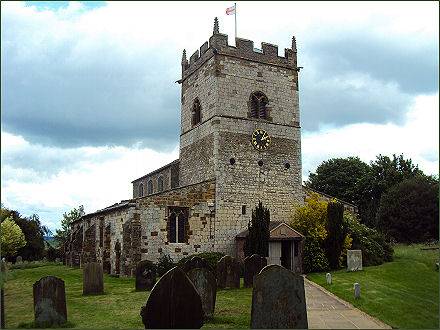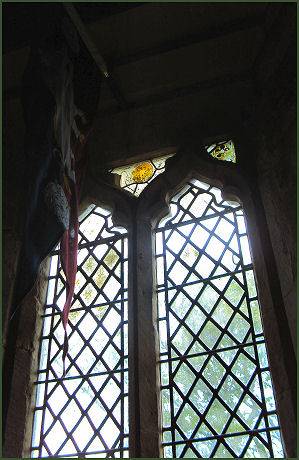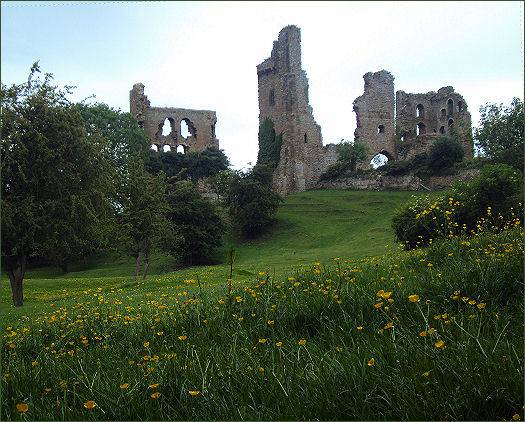Sheriff Hutton
OS grid reference:- SE 652 664
 The village of Sheriff Hutton is located around six miles (10km) from York and stands on a ridge between the Vale of York and the Howardian Hills.
The village of Sheriff Hutton is located around six miles (10km) from York and stands on a ridge between the Vale of York and the Howardian Hills.
 The village's name derives from the Anglo-Saxon words hoh and tun,
which mean settlement on a projecting piece of land. The prefix of Sheriff is thought to have been added because the manor was once held by Bertram de Bulmer, the Sheriff of York, who died in 1166.
The village's name derives from the Anglo-Saxon words hoh and tun,
which mean settlement on a projecting piece of land. The prefix of Sheriff is thought to have been added because the manor was once held by Bertram de Bulmer, the Sheriff of York, who died in 1166.
Sheriff Hutton is an ancient settlement and is mentioned in the Domesday Book of 1086. Prior to the Norman invasion the manor was split between several land owners. Those named included Ligulf, Northmann, Thorkil, Thorsten and Thorulf.
Sheriff Hutton once formed part of the Galtres Forest, which was established in North Yorkshire by the Norman kings of England. Following the Norman conquest of 1066, some of the lands were retained by the Crown and others given to Count Robert of Mortain, the maternal half-brother of William the Conqueror, who installed Sir Nigel Fossard as lord of the manor.
Soon after this, the land was in the possession of the Bulmer family. Ansketil de Bulmer built the first castle at Sheriff Hutton during the reign of King Stephen. This was a Norman timber motte and bailey structure of which only the mounds now remain. Bulmer's castle was rebuilt in stone in the late fourteenth century by John, Lord Neville, son of John Neville, 3rd Baron Neville de Raby.
When Henry II succeeded to the throne after the civil war between Stephen and Matilda, the castle and manor were seized by the Crown before being held for the king by the Mauley family. The manor eventually to came into the possession of the aristocratic Neville family in the thirteenth century until they were surrendered to the Crown in the late fifteenth century.
The parish Church, dedicated to St Helen and Holy Cross, a Grade I listed building, lies to the east of the village and dates back to at least the early twelfth century. There is a small window above the west door that may pre-date 1100.
 The Norman church is thought to constructed with re-used stone from York's Roman walls. It consists of a tower, nave and chancel,
all of which were later extended when the four chantry chapels were built in the fifteenth century for the families of the Neville, Gower, Wytham and Dacre.
The Norman church is thought to constructed with re-used stone from York's Roman walls. It consists of a tower, nave and chancel,
all of which were later extended when the four chantry chapels were built in the fifteenth century for the families of the Neville, Gower, Wytham and Dacre.
There are several references to the Yorkist branch of the Plantagenet family, including the Sun in Splendour emblem of King Edward IV and Neville and Dacre shields in the stained glass. The church also contains the tomb of Sir Edmund Thweng, who was killed at the Battle of Stirling in 1344.
 A monument to Richard III's only legitimate son stands in the church, Edward of Middleham in March 1484, the exact date of his death remains a matter of controversy, with some sources citing 31st March as the date and others 9th April. Both Richard and his wife Anne Neville were reported to have been distracted by their grief. Richard later appointed his sister's son, John de la Pole, as his successor.
A monument to Richard III's only legitimate son stands in the church, Edward of Middleham in March 1484, the exact date of his death remains a matter of controversy, with some sources citing 31st March as the date and others 9th April. Both Richard and his wife Anne Neville were reported to have been distracted by their grief. Richard later appointed his sister's son, John de la Pole, as his successor.
Edward, earlier known as Earl of Salisbury, was born at Middleham Castle between April 1473 and December 1474. It is suspected that Edward, believed to have been a delicate child, was too ill to travel to his parents' coronation at Westminster Abbey on 6th July, 1483, but was appointed nominal Lord Lieutenant of Ireland on 19th July . He was invested as Prince of Wales at a ceremony at York Minster on 24th August.
The mutilated white alabaster effigy, believed to be that of Edward of Middleham, against north wall of the church is not a tomb but a cenotaph (i.e. it is empty). Edward's body is presumed to lie in the southern side of the church, in the ancestral chapel of the Nevilles, his mother's family. The monument was dimantled at some unknown date, attempts at cleaning and conservation were made in the nineteenth century and the monument was finally reassembled in the twentieth century and provided with a new core and damp course at the expense of the Richard III Society.
George Neville, Duke of Bedford, the son of John Neville, Marquis Montagu is also buried in the church, although no monument exists to him.
To the south of the castle is Sheriff Hutton Park, which has belonged to the manor since 1335, when licence was granted Ralph de Neville to impark his woods of Sheriff Hutton and make a deer-leap. The house was built by Sir Arthur Ingram in 1621.
Sheriff Hutton Castle
Sheriff Hutton Castle was founded as a motte and bailey castle by one Ansketil de Bulmer during the reign of King Stephen. This was a Norman timber motte and bailey structure of which only the mounds now remain. In 1331 the powerful and influential Neville family obtained overlordship of Sheriff Hutton and Bulmer's castle was rebuilt in stone in the late fourteenth century by John, Lord Neville, son of John Neville, 3rd Baron Neville de Raby.

The castle, which now stands in romantic ruins within the grounds of a farm, is quadrangular in form, with four crumbling corner towers connected by ranges of buildings, enclosing an inner courtyard. The northern and western sides are straight, whereas those on the south and east contain obtuse, outward pointing angles at their centres.
